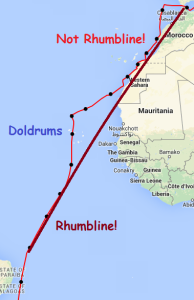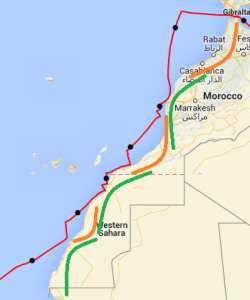 By ‘blind’ I mean that we’re not looking at the actual forecast, these are basic strategies that do have value in the right situation.
By ‘blind’ I mean that we’re not looking at the actual forecast, these are basic strategies that do have value in the right situation.
1. The rhumbline
The shortest distance between two points is a line. Point at your waypoint, go max VMG if needed.Pros: you get to your destination eventually.
It’s the shortest route, sort of.
Sometimes the fastest route, if only by accident.
Cons: Look, we’re talking about sailboats, not ballistic missiles.
A straight line is not efficient in windshifts, and if you end up going max VMG a lot that’s just slow.
When: stable wind, either over a short time or in the trades.
If your boat moves at hull speed in every direction.
2. VMC sailing
You speed up and maximise the gain towards your waypoint.
Pros: You go somewhere fast.
You shoot up the leaderboard. Well. Yay. I am overjoyed.
Supposedly faster than rhumbline on average.
Cons: The problem with somewhere is, you have a specific destination. VMC is an important concept, but the special case of VMC to the waypoint is not how the fast boats use it.
Laughably bad the closer you get to the waypoint.
One could call this instant gratification routing. You get the easy miles now, which beats not getting the easy miles at all, but you may end up badly out of position. And consider efficiency… a boat on the rhumbline is 100% efficient. If the best VMC sends you 30 degrees off, that’s still 86% efficient, usually not a problem. But 30 degrees in the opposite direction is also 86%, even with less speed. Which gives the better position long term? The VMC number can’t tell you that.
When: The only time I would use this is if the wx is a total mess, let’s say you round Cape Horn with 1h to the next wx update… but ideally never.
3. Sailing by ancient knowledge
When you start a RTW race you know that ‘west is best’. On the Southern Ocean you know to dive south ASAP. Etc…
On a more methodical level, you do weather routing on prevailing winds charts.
Pros: Your route has worked in the past.
You can draw up a decent route months in advance.
Cons: There is no such thing as ‘normal’ weather.
When: Long races, all ocean races period. I’ll do some examples later, when I’ve covered weather routing…

4. Stick to the coast
A number of important factors are 50-50, wind on the shore could be stronger or weaker, a shift could mean you tack on the beach or sail far offshore, IRL currents could go both ways, you have to consider BBQ opportunities, etc…
One fact I want to highlight, wind likes to follow the coastline. Coasts are always curved, so you get a bit of rotation. Aim at the center of rotation for the slingshot effect!

thank you.